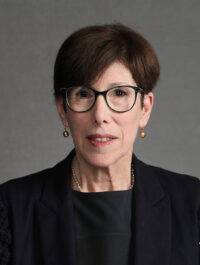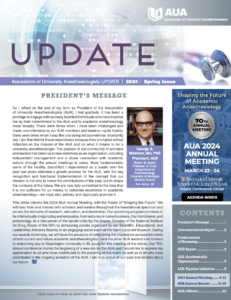Diversity and Anesthesiology
The definition of “academic” is “relating to scholarship and education”; this definition suggests an openness to ideas and change, as new knowledge should lead to changes in behavior. In medicine, change in physician behavior is often slow for unclear reasons—and to the detriment of patient care. Ignaz Philipp Semmelweis was a Hungarian obstetrician who discovered the cause of puerperal fever in 1847 when he was a 29-year-old Chief Resident ("first assistant") in the first clinic of the lying-in division of the Vienna General Hospital. Childbed [CBF] or puerperal fever was then the leading cause of maternal mortality. Semmelweis implemented chlorine hand disinfection to remove organic matter from the hands of the attendants, as soap and water alone had been ineffective. Hand disinfection reduced the maternal mortality from CBF 3- to 10-fold, yet most leading obstetricians rejected Semmelweis' doctrine because it conflicted with all theories of the cause of CBF. Sadly, 200 years later we are still trying to achieve universal hand disinfection using alcohol by all patient care-providers.
The AUA was formed to be an academic organization for Anesthesiologists in 1953—to help lead in scholarship, education, innovation and progress in the field. To continue with this mission, there have been changes in the organization of the AUA. A novel pathway for early scholars was created and this membership component has increased and brought new ideas and vigor to the organization. The AUA has affiliated with the IARS to expand the organizational membership beyond the United States and improve communication with the world’s anesthesia scholarly organizations. These changes have led to positive outcomes, including more collaboration on clinical research [IMPACT studies]. And the AUA is now attempting to increase its diversity of members for the numerous reasons explained below.
There is increasing recognition that medical care must consider social determinants of health; there are “health disparity populations, including racial/ethnic minorities, less privileged socio-economic status, underserved rural residents, sexual gender minorities and populations subject to discrimination.”1,2
Black and Latino physicians provide more care for the underserved; Black MDs cared for more black patients with Medicaid coverage and Latino MDs saw more Latino patients and more uninsured patients.3
We want to educate more diverse anesthesiologists to help care for our all of the world’s populations. This would be a very positive outcome, given the lack of anesthesiologists in Africa and in much of the world’s poorer economies.
There are other benefits to increasing the diversity of our faculty and AUA membership. There is data to document the academic and the scientific benefit of more diverse faculty; papers written by a diverse group receive more citations and are published in journals with higher impact factors.4 This is also true for gender diversity. Gender-heterogeneous working groups produce higher quality science.5
Sadly, there is also data that bias is pervasive in science and in medicine. R01 funding less likely to go to African Americans than White applicants. Although proposals with strong priority scores were equally likely to be funded regardless of race, Asians are 4 percentage points and black or African-American applicants are 13 percentage points less likely to receive NIH investigator-initiated research funding compared with whites. After controlling for the applicant's educational background, country of origin, training, previous research awards, publication record, and employer characteristics, we find that black applicants remain 10 percentage points less likely than whites to be awarded NIH research funding.6
How is gender diversity in Anesthesia? Well not great. The percentage of medical school graduates, anesthesiology residents, and anesthesiology faculty members who are women has increased since 1985; however, the rate of increase in the percentage of women is significantly faster for medical school graduates compared with anesthesiology residents (P < 0.001) and faculty (P < 0.05). The percentage of women anesthesiology faculty members who were full professors in 2006 was 6.5% compared with 17.7% of men faculty (P < 0.001) and is not significantly different than in 1986 (P = 0.27). Fourteen percent of full anesthesiology professors were women and this does not differ from all clinical specialties combined (15%). Women comprised 12.7% of academic anesthesiology chairs and 10% of all medical school department chairs in 2006, significantly higher compared with 1993 (P < 0.05). Currently, 8% and 11% of editors and associate editors of Anesthesiology and Anesthesia & Analgesia are women, respectively. Eighteen percent of American Board of Anesthesiology oral board examiners in 2007 were women compared with 8% in 1985 (P < 0.05). The percentage of time in which women have served as anesthesiology society leaders was significantly greater during 1997-2006 compared with 1987-1996 (P < 0.001). The proportion of competitive research grants awarded to women has not changed over several decades.7
The AUA council created a task force for Diversity and Inclusivity in May 2019 and held its first meeting at the AUA meeting in 2019. The taskforce recommended an exploration of the current membership demographics and a survey to collect feedback on the future direction of the organization. The findings of the survey documented that 475 surveys were completed, and white men make up 72% of those who responded to the survey and 68% or 326 white male members were over 51 years of age. In fact, 42% of all responders to the survey were older than 61 years of age. Only 57 of the men who responded were not white; only 1.8% of the male respondents identified themselves as African American or Black. There were 80 respondents identifying themselves as women; 68% of the women were identified as white and 37 women were identified as other than white, including 15.6 % as Asian and 6.6% as Black or African American.8
Therefore, the women members were more diverse than the men and younger than the men; ~46% of the women were 50 years or younger. Notably, ~17% of underrepresented minority faculty were associate members and this is in contrast to ~5% of the white respondents.
The conclusions that can be drawn from the survey are that we need to actively recruit more diverse members, as our membership does not represent the current medical school population at all. Furthermore, the mission of the AUA, to enhance scholarship and education, needs to be transmitted by more than chairs of departments, as many full and associate members stated they did not have chairs that actively participate in the AUA. The other findings of the survey will be discussed at the next business meeting at the AUA 2020.
If the goal of the AUA is to increase the scholarship and education in anesthesiology, we must increase our diversity, so as to improve our science and broadening of our information exchanges.9
Anesthesiology is not the most diverse academic field and for the reasons stated above, we must work harder to improve this. Ideas include promoting mentoring of all of our young faculty, but especially our underrepresented minority faculty.10
We welcome your input and ideas; our goal is to expand our knowledge and thinking and that is why we are proposing to create a third board of the AUA, that of Leadership and Diversity, so that we can continue to be the home of scholarship and education in anesthesia.
References
- Eliseo Perez-Stable, Director of National Institute on Minority Health and Health Disparities
- Komaromy M et al. New England Journal of Medicine [1996] 334:1305-10
- Marrast LM et al. JAMA Internal Medicine [2014] 174:289-290]
- Freeman R. B, Huang W. [2014] National Bureau of Economic Research # w19905
- Campbell LG et al [2013] PLOS One
- Ginther DK, Schaffer WT, Schnell J, et al. Race, ethnicity and NIH research awards. Science 2011; 333:1015-9
- Wong CA, Stock MC. The Status of Women in Anesthesiology: A Progress Report. Anesthesia Analgesia 2008; 107:178-84
- Maya Hastie, Robert Whittington, authors of the survey
- Sommers SR [2006] On racial diversity and group decision making; identifying multiple effects of racial composition on jury deliberations. Journal of Personality and Social Psychology 90(4). 597
- Nafiu OO, Haydar B. Mentoring programs in academic anesthesiology: a case for PROFOUND mentoring for underrepresented minority faculty. Anesthesia & Analgesia 2019; 129:316-320











